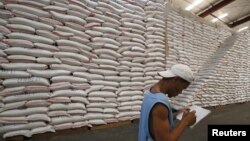BASEY, SAMAR PROVINCE, PHILIPPINES —
Some farmers in the central Philippines are preparing for their first rice harvest since last November’s powerful super typhoon swept away their fields and homes, and killed more than 6,200 people.
Florencio de la Cruz said he had harvested six tons of rice less than two weeks before super typhoon Haiyan’s howling winds blew off his storehouse roof and brought soaking rain. The sun helped dry some of the harvest and he was able to recover a little.
Then late last year de la Cruz received rice seeds from the United Nations’ Food and Agriculture Organization. The organization helped start the planting season in this part of the country where more than two thirds of the population lives in poverty.
De la Cruz said, nothing would have happened without the seed program because they lost all their crops and even their house.
De la Cruz expects to reap the new crop on March 28. He has been farming rice on a one-hectare patch of land for more than 50 years. His family is among the 44,000 that the Food and Agriculture Organization says has so far been helped by the seed program.
Late last year officials said 63,000 hectares of rice had to be replanted after Haiyan struck.
Philippine officials said the FAO contributed 52 percent of the required seeds, while the international community added another 28 percent and the rest came from the government. They said after typhoon Bopha struck the southern Philippines in 2012, the government’s seed stock was depleted.
On Monday FAO Director General Graziano da Silva inspected the seed program in Basey municipality where de la Cruz lives. He said the farmers are receiving “certified quality” seeds, which should bring greater yields than what they have now.
But he said the first batch of seeds was rushed out in less than ideal conditions. “Remember the typhoon came exactly in the moment that was close in the time for another planting and we needed to do it in a week, two weeks and we did it. The most import is the result would be zero if we did not provide those,” he said.
Da Silva said under the circumstances the response from the international community and other agencies in the Philippines was one of the quickest he has seen.
He said the next step is to make sure the farmers get a fair price for their rice crops, and that this would spur them to plant even more.
Agencies are also trying to recover the 33 million coconut trees that they say the typhoon obliterated. Philippine Agriculture Department officials said on Thursday a massive coconut clearing operation will get underway throughout the typhoon stricken region. The goal is get the trees replanted, which will then need at least four years to mature and bear fruit. In the meantime, they plan to help coconut farmers plant fast-growing crops like cassava and white corn.
Florencio de la Cruz said he had harvested six tons of rice less than two weeks before super typhoon Haiyan’s howling winds blew off his storehouse roof and brought soaking rain. The sun helped dry some of the harvest and he was able to recover a little.
Then late last year de la Cruz received rice seeds from the United Nations’ Food and Agriculture Organization. The organization helped start the planting season in this part of the country where more than two thirds of the population lives in poverty.
De la Cruz said, nothing would have happened without the seed program because they lost all their crops and even their house.
De la Cruz expects to reap the new crop on March 28. He has been farming rice on a one-hectare patch of land for more than 50 years. His family is among the 44,000 that the Food and Agriculture Organization says has so far been helped by the seed program.
Late last year officials said 63,000 hectares of rice had to be replanted after Haiyan struck.
Philippine officials said the FAO contributed 52 percent of the required seeds, while the international community added another 28 percent and the rest came from the government. They said after typhoon Bopha struck the southern Philippines in 2012, the government’s seed stock was depleted.
On Monday FAO Director General Graziano da Silva inspected the seed program in Basey municipality where de la Cruz lives. He said the farmers are receiving “certified quality” seeds, which should bring greater yields than what they have now.
But he said the first batch of seeds was rushed out in less than ideal conditions. “Remember the typhoon came exactly in the moment that was close in the time for another planting and we needed to do it in a week, two weeks and we did it. The most import is the result would be zero if we did not provide those,” he said.
Da Silva said under the circumstances the response from the international community and other agencies in the Philippines was one of the quickest he has seen.
He said the next step is to make sure the farmers get a fair price for their rice crops, and that this would spur them to plant even more.
Agencies are also trying to recover the 33 million coconut trees that they say the typhoon obliterated. Philippine Agriculture Department officials said on Thursday a massive coconut clearing operation will get underway throughout the typhoon stricken region. The goal is get the trees replanted, which will then need at least four years to mature and bear fruit. In the meantime, they plan to help coconut farmers plant fast-growing crops like cassava and white corn.






